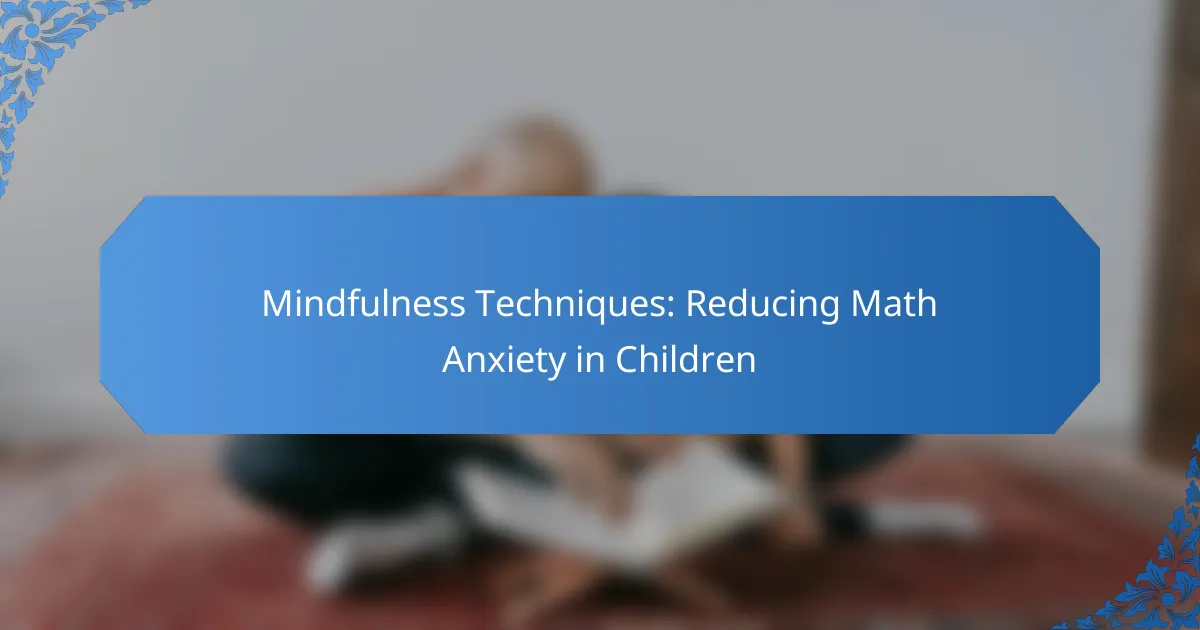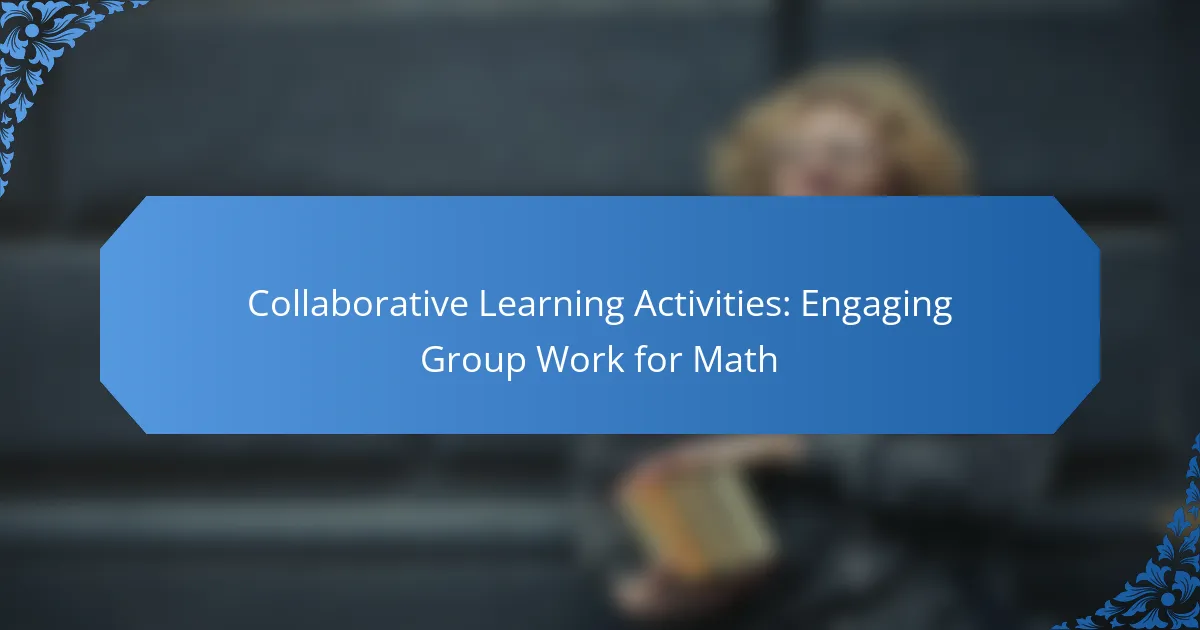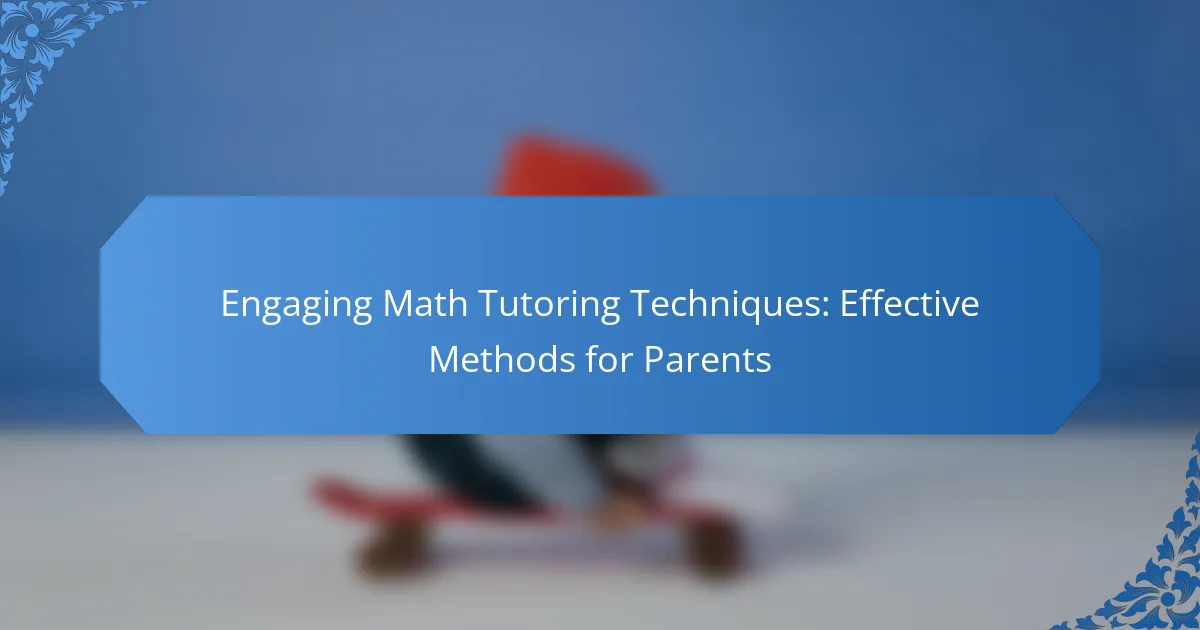Math anxiety is a common challenge faced by children, but mindfulness techniques can provide effective relief. By promoting relaxation, focus, and a positive mindset, these practices help children manage stress and build confidence in their math abilities. Implementing mindfulness at home and in schools can create a supportive environment that makes learning math more enjoyable and less daunting.
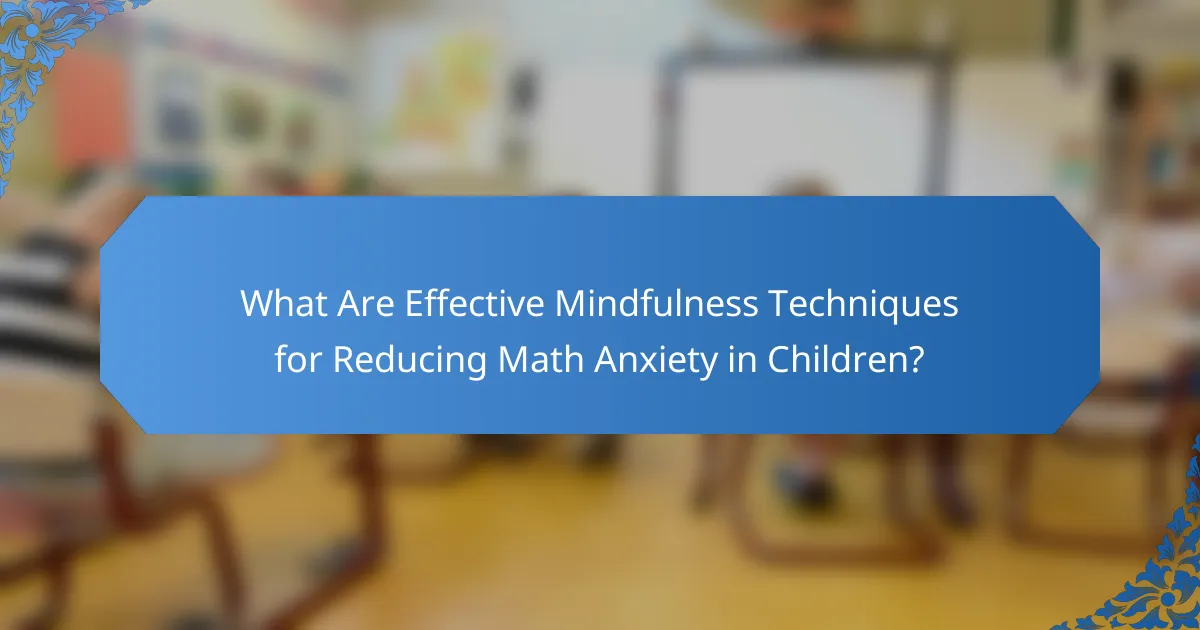
What Are Effective Mindfulness Techniques for Reducing Math Anxiety in Children?
Effective mindfulness techniques for reducing math anxiety in children include practices that promote relaxation, focus, and a positive mindset. These methods help children manage their stress and improve their confidence when tackling math-related tasks.
Breathing exercises
Breathing exercises are simple yet powerful tools for calming the mind and body. Children can practice deep breathing by inhaling slowly through the nose, holding for a few seconds, and exhaling through the mouth. This technique can be done for a few minutes before a math test or homework session to reduce anxiety.
Encourage children to count their breaths, aiming for a count of four while inhaling and six while exhaling. This rhythmic breathing can help lower heart rates and create a sense of calm, making math feel less daunting.
Guided imagery
Guided imagery involves visualizing peaceful and positive scenarios to alleviate anxiety. Children can be guided to imagine themselves successfully solving math problems in a serene environment, such as a quiet park or a cozy room. This mental rehearsal can boost their confidence and reduce fear associated with math.
To practice, parents or educators can lead a short session where they describe a calming scene and encourage children to picture themselves achieving their math goals within that setting. This technique can be especially effective before tests or challenging assignments.
Mindful movement
Mindful movement incorporates physical activity with awareness, helping children release tension and focus their minds. Simple activities like stretching, yoga, or even a short walk can serve as a break from math tasks, allowing children to reset their thoughts.
Encourage children to engage in mindful movement for about 5-10 minutes, focusing on their body and breath. This practice can enhance concentration and reduce feelings of anxiety when they return to their math work.
Journaling
Journaling provides a space for children to express their thoughts and feelings about math. Writing about their experiences, fears, or successes can help them process emotions and gain perspective. Encourage them to write regularly, focusing on both challenges and achievements in math.
Children can also use journaling to set goals for their math studies, which can foster a sense of control and motivation. A simple structure, such as writing three things they learned or felt during math each day, can be beneficial.
Positive affirmations
Positive affirmations are statements that encourage a growth mindset and self-belief. Children can create affirmations related to math, such as “I am capable of solving math problems” or “I enjoy learning new math concepts.” Repeating these affirmations can help shift their mindset towards a more positive outlook.
Incorporate affirmations into daily routines, such as saying them aloud in the morning or writing them in a journal. This practice can reinforce their confidence and reduce anxiety associated with math challenges.
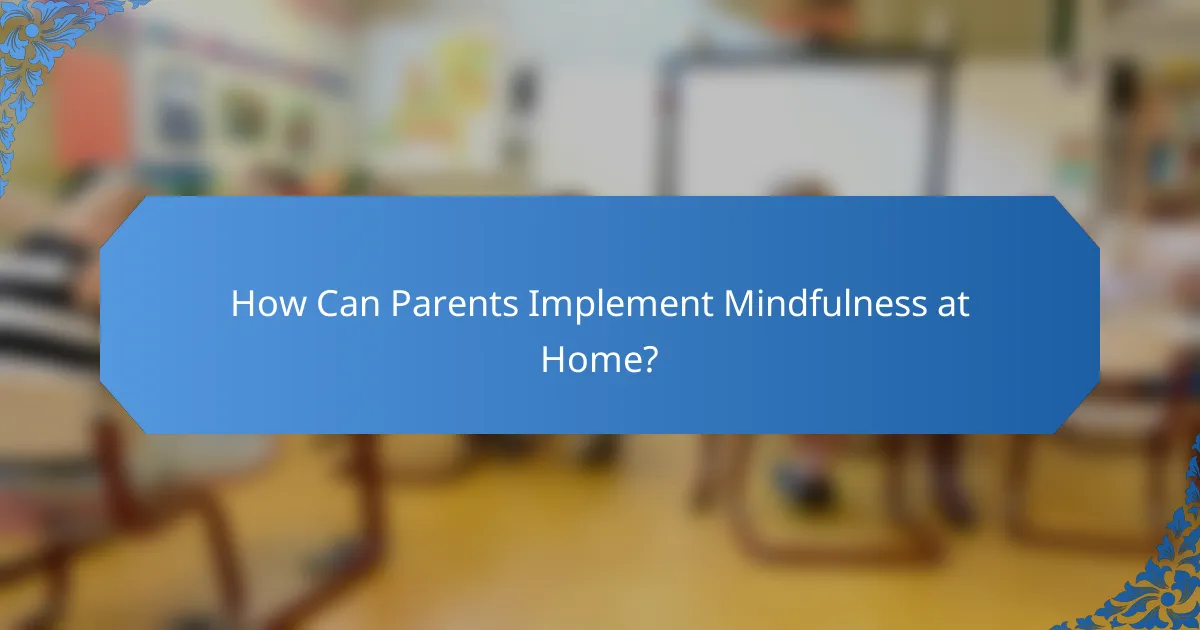
How Can Parents Implement Mindfulness at Home?
Parents can effectively implement mindfulness at home by integrating simple practices into daily routines. These techniques help children manage math anxiety by fostering a sense of calm and focus, making learning more enjoyable and less stressful.
Daily mindfulness routines
Establishing daily mindfulness routines can significantly benefit children. Simple practices like deep breathing exercises or short meditation sessions can be incorporated into morning or evening rituals. Aim for 5-10 minutes each day to help children develop a habit of mindfulness.
Consider using guided mindfulness exercises that are age-appropriate. These can include visualizations or body scans, which help children connect with their feelings and reduce anxiety related to math or other subjects.
Creating a calm environment
A calm environment is essential for practicing mindfulness. Designate a quiet space in your home where children can relax and focus without distractions. This space should be free from clutter and equipped with comfortable seating and calming visuals.
Incorporate elements that promote tranquility, such as soft lighting, soothing colors, and gentle sounds like nature or soft music. Encourage children to use this space for mindfulness activities, especially before tackling math homework.
Using mindfulness apps
Mindfulness apps can be a valuable tool for children to practice mindfulness independently. Many apps offer guided meditations, breathing exercises, and mindfulness games tailored for younger audiences. Look for apps that are user-friendly and have positive reviews from parents.
Some popular options include Headspace for Kids and Calm, which provide engaging content specifically designed for children. Encourage your child to explore these resources and choose what resonates with them to enhance their mindfulness journey.
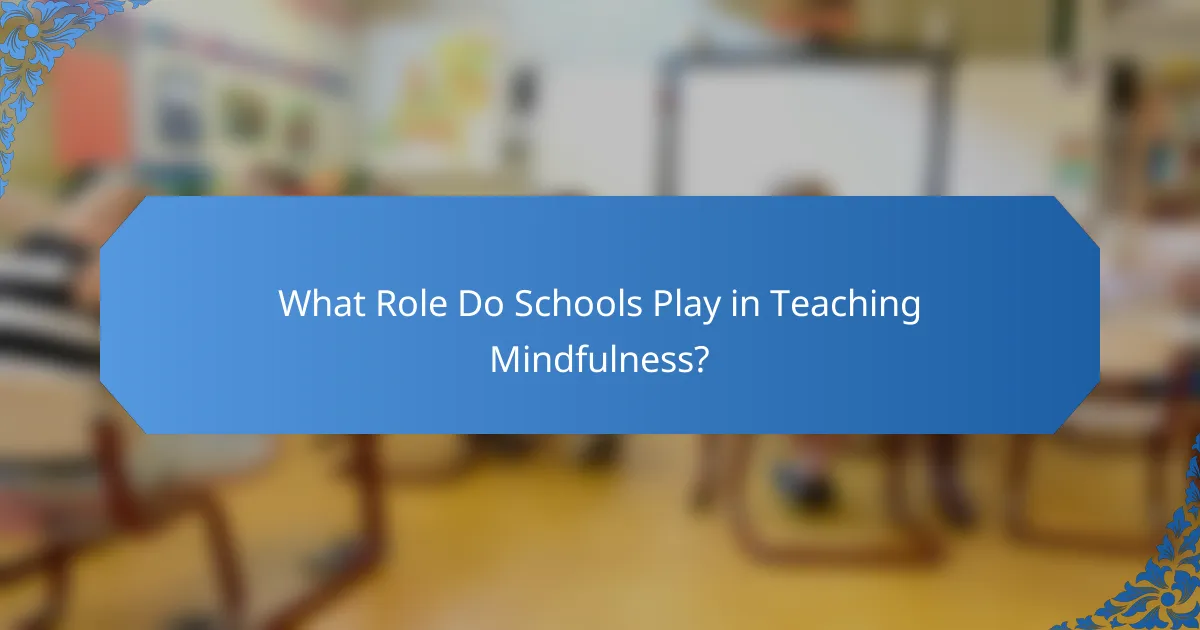
What Role Do Schools Play in Teaching Mindfulness?
Schools play a crucial role in teaching mindfulness by integrating it into daily activities and promoting a supportive environment. By incorporating mindfulness practices, schools can help reduce math anxiety in children, fostering better focus and emotional regulation.
Incorporating mindfulness in the curriculum
Integrating mindfulness into the curriculum can be achieved through various methods, such as dedicated mindfulness classes or incorporating short mindfulness exercises into existing subjects. For example, teachers can start math lessons with a few minutes of deep breathing or guided visualization to help students center themselves.
Additionally, schools can use mindfulness techniques during transitions between classes or after recess to help students refocus. Simple practices, like mindful walking or stretching, can be effective in creating a calm atmosphere conducive to learning.
Training teachers in mindfulness
Training teachers in mindfulness is essential for effective implementation. Professional development programs can equip educators with the skills to practice mindfulness themselves and teach it to their students. Workshops can cover techniques such as mindful breathing, body scans, and stress reduction strategies.
Moreover, ongoing support and resources for teachers can enhance their confidence in using mindfulness techniques. Schools might consider partnering with local mindfulness organizations to provide training sessions and materials tailored to their specific needs.
Hosting workshops for parents
Hosting workshops for parents can extend the benefits of mindfulness beyond the classroom. These workshops can educate parents about mindfulness practices and their positive impact on children’s emotional well-being and academic performance. Parents can learn techniques to support their children at home, such as mindfulness games or family meditation sessions.
Offering these workshops in the evenings or on weekends can increase participation. Schools can collaborate with community centers or mental health professionals to provide expert-led sessions that engage parents and encourage a supportive home environment for mindfulness practices.

What Are the Benefits of Mindfulness for Children with Math Anxiety?
Mindfulness techniques can significantly benefit children experiencing math anxiety by promoting emotional regulation and enhancing cognitive function. These practices help children focus better, reduce stress, and improve their problem-solving abilities, making math more approachable and less intimidating.
Improved focus
Mindfulness helps children develop better focus by training their attention to remain on the task at hand. Techniques such as deep breathing or guided imagery can redirect their thoughts away from anxiety and distractions, allowing them to concentrate on math problems more effectively.
For instance, a simple practice like the “5-4-3-2-1” grounding exercise can help children identify their surroundings and refocus their minds before tackling math assignments. This method encourages them to acknowledge their feelings without letting anxiety overwhelm their concentration.
Reduced stress levels
Practicing mindfulness can lead to lower stress levels in children, which is crucial for those facing math anxiety. Regular mindfulness exercises, such as meditation or yoga, can help children manage their emotional responses and cultivate a sense of calm.
Encouraging children to take short breaks during math homework to practice mindfulness can be effective. For example, spending just a few minutes focusing on their breath can significantly decrease feelings of stress and allow them to approach math with a clearer mindset.
Enhanced problem-solving skills
Mindfulness can enhance children’s problem-solving skills by fostering a flexible mindset. When children practice mindfulness, they learn to approach challenges with curiosity rather than fear, which can lead to more creative solutions in math.
Incorporating mindfulness into math lessons can be as simple as encouraging children to pause and reflect on a problem before jumping to conclusions. This pause allows them to consider multiple strategies and choose the best approach, ultimately improving their mathematical reasoning.
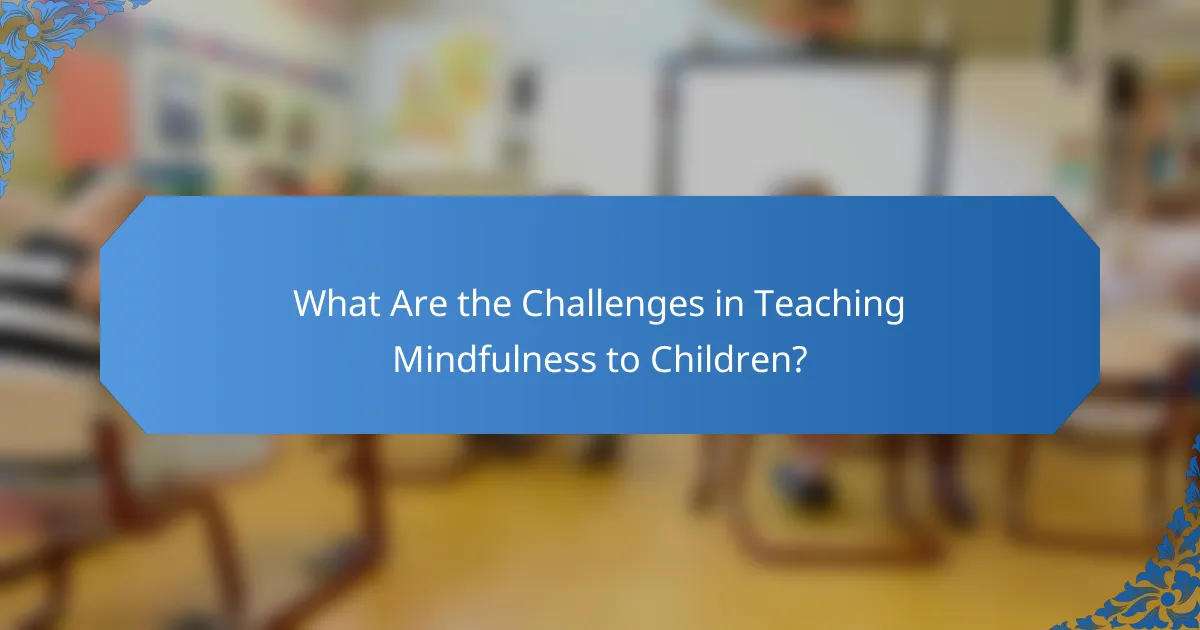
What Are the Challenges in Teaching Mindfulness to Children?
Teaching mindfulness to children can be challenging due to various factors, including their natural resistance to new practices and the lack of available resources. Understanding these challenges is essential for effectively implementing mindfulness techniques aimed at reducing math anxiety.
Resistance from children
Children often resist mindfulness practices because they may find them boring or difficult to understand. This resistance can stem from a lack of interest in introspective activities or a preference for more active forms of engagement. To overcome this, educators can incorporate playful elements, such as games or storytelling, to make mindfulness more appealing.
Additionally, introducing mindfulness gradually can help ease children into the practice. Starting with short sessions of just a few minutes can allow them to become familiar with the concept without feeling overwhelmed. Consistency is key; regular practice can help children develop a more positive attitude toward mindfulness over time.
Lack of resources
A significant barrier to teaching mindfulness is the lack of resources, including trained instructors and appropriate materials. Many schools may not have access to mindfulness programs or curricula designed specifically for children. To address this, educators can seek online resources, such as guided meditation apps or free lesson plans tailored for younger audiences.
Collaboration with parents can also enhance resource availability. Schools can encourage parents to engage in mindfulness activities at home, creating a supportive environment that reinforces what children learn in the classroom. Sharing simple techniques, such as breathing exercises or mindful observation, can empower families to practice together, making mindfulness a community effort.
